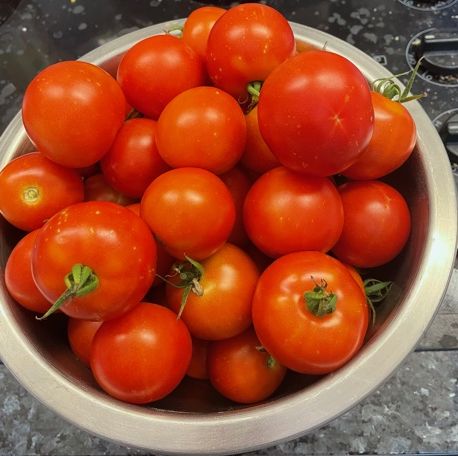Forum Replies Created
-
AuthorPosts
-
Other than my five 4th of July plants, which are one of the earliest varieties available, I think I've gotten 2 Rutgers, 1 Brandywine and 1 Italian heirloom from the other 19 plants. I think by next weekend we may be getting ripe fruit on another dozen or so plants. The Amish Paste tomatoes have a nice crop going, but none are showing color yet. They are determinate and tend to be an 'all at once' variety, big pear tomatoes that make great sauce.
We've gotten 2 or 3 eggplants and there should be a few more shortly. (My wife doesn't really like to eat eggplant, except occasionally in ratatouille, but she likes to watch it grow, so we have two plants and will probably give nearly all of it away.)
I picked 5 pounds of 4th of July tomatoes today, each one weighs about two ounces and is around 1.75 inches in diameter.
Attachments:
You must be logged in to view attached files.We're getting more 4th of July tomatoes than we can eat right now, even though we've given a number of them away. I may have to start blanching and freezing them, I don't think I've got quite enough to justify trying to make tomato juice or sauce.
Today I picked a couple of Rutgers and a Brandywine. I've got a First Lady turning color. If we get some cooler weather, we may still get a bountiful harvest in September.
We had left over spaghetti and meatballs with fresh semolina bread, and a Rutgers tomato from the garden.
One of the local grocery chains started carrying King Arthur AP flour the other day, but at a price higher than the other local/regional chain. And I can buy it for a lot less at Costco, where I can get it for under 50 cents a pound, half of what it costs elsewhere.
My plan is to make semolina bread today. I was going to try a mixture of semolina and durum flour, which I thought I had a container of, but I couldn't find it the other day. And I know better than to try to find it locally.
I am using a 60/40 blend of semolina and bread flour again today, and I'm using some non-diastatic barley malt instead of sugar, just to see what happens.
Diastatic malt has diastatic enzymes in it, those help to break down the starches in the endosperm into sugars, mostly maltose.
Most yeast strains prefer glucose or fructose over maltose, though they will use maltose if that's the only sugar available. But the yeast activity is more vigorous with glucose or fructose. That suggests that a longer/slower ferment is desirable when the primary sugar available will be maltose. Whether it is best done in the refrigerator or at room temperature is debatable, both have their positives and negatives.
Kind of hot for it, but we had spaghetti and meatballs today, it just sounded good.
I have always been underwhelmed by Whole Foods, and it hasn't gotten better since it was purchased by Amazon.
I had two slices of bread with peanut butter and some steamed cauliflower for supper.
Boy, your picture didn't look anything like this site:
downy mildew in basilDo you have a local extension service you can ask?
Silicone muffin cups are going to be quite a bit bigger, but the basic idea would probably work. These tend to be a bit brittle, larger ones might be more likely to break while handling them.
I also liked using a microplane to even out the edges, the last time I made sablé breton tarts the uneven edges were a visual distraction.
We wound up having salads with tuna fish, plus some steamed broccoli/cauliflower. (The induction burner doesn't heat the kitchen up much, it is getting a lot of use this summer.)
My wife, a master gardener, says it is probably a nutrient deficiency in your basil, she just doesn't remember which one. (Google says phosphorus.) There are also some nutrients where an excess of them can cause purple splotches.
I think durum flour might have a higher ash content than semolina, because it often contains the middlings that are left over when semolina is made. Durum is generally used for softer forms of pasta, but for bread I don't know if it makes much difference. I've seen some products that used both durum flour and semolina, though.
Durum flour seems harder to find than semolina, that may be because semolina is used more.
-
AuthorPosts
